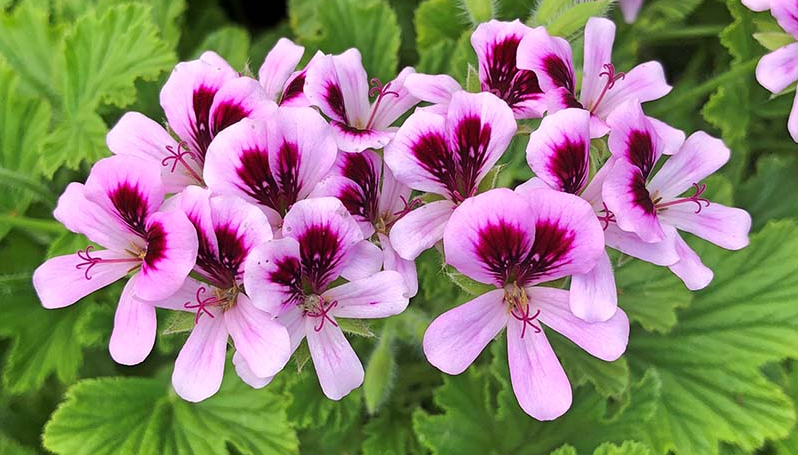
The term “scented-leaved geraniums” refers to a group of species within the Pelargonium genus that have leaves that emit a fragrance when touched or lightly bruised. These plants are within the large group we generally know as “garden geraniums” or “annual geraniums,” which also includes ivy geraniums, zonal geraniums, and Martha Washington geraniums.
Common name notwithstanding, it’s important to note that this entire group is different than the various cranesbill geraniums, or “true geraniums”—the plants that have the rightful claim to the name Geranium. The plants we know as garden geraniums were once part of that genus, but after they were separated into their own Pelargonium genus in 1789, the use of the common name persisted, right up to this day.
Scented-leaved geraniums (Pelargonium spp.) have glands at the base of their leaf hairs where the scented oil is formed. Crushing the leaves—or in some cases merely touching them—releases the oil and the scent. However, the leaves of scented geraniums closely resemble those of other garden pelargoniums, so you can’t always tell the type of geranium just by looking. These plants have many leaf shapes, from round to finely cut and lacy, and leaf colors from gray-green to lime green.
Most scented geraniums have relatively small flowers; some are quite lovely, and some are so tiny you will barely notice them. Each flower has five petals, two larger upper petals, and three smaller lower petals. Scented geraniums are primarily grown for their fragrant leaves rather than their flowers.
How To grow and care for scented geraniums
USDA Hardiness Zones
| Zone 9 | 20°F to 30°F (-6.7°C to -1.1°C) | Suitable with protection during occasional frosts or freezes. |
| Zone 10 | 30°F to 40°F (-1.1°C to 4.4°C) | Provides favorable conditions for growing scented geraniums as perennials. |
| Zone 11 | Above 40°F (4.4°C) | Ideal conditions for scented geraniums to thrive year-round as perennials without frost damage. |
Planting Location
- Geraniums prefer full sun but can tolerate partial shade, especially in hotter climates.
- Ensure the planting location has well-drained soil to prevent waterlogging, as geraniums are susceptible to root rot.
Planting Time
- In cooler climates, plant geraniums after the last frost date in spring.
- In warmer climates, geraniums can be planted in fall or winter for winter and spring bloom.
Soil Preparation
- Use well-draining soil with a pH of 6.0 to 7.5.
- Incorporate organic matter like compost into the soil before planting to improve drainage and fertility.
Planting
- Dig a hole slightly larger than the root ball of the geranium.
- Place the plant in the hole and backfill with soil, gently firming it around the plant.
- Space plants 12 to 18 inches apart, depending on the cultivar.
Watering
- Water geraniums thoroughly after planting and keep the soil evenly moist until established.
- Once established, allow the soil to dry out slightly between waterings. Avoid overwatering, as this can lead to root rot.
Fertilizing
- Feed geraniums with a balanced fertilizer (10-10-10 or similar) every 4 to 6 weeks during the growing season.
- Avoid excessive fertilization, as it can lead to leggy growth and fewer flowers.
Pruning and Deadheading
- Pinch back young geranium plants to encourage bushy growth.
- Deadhead spent flowers regularly to promote continuous blooming.
- Remove yellowing or dead leaves to improve air circulation and reduce disease risk.
Overwintering (for colder climates)
- In regions with frost, geraniums can be overwintered indoors.
- Before the first frost, dig up geranium plants from the garden and pot them in containers.
- Place the containers in a cool, sunny location indoors and water sparingly during the winter months.
Pest and Disease Control
- Monitor plants regularly for pests such as aphids, spider mites, and whiteflies. Use insecticidal soap or neem oil to control infestations.
- Keep foliage dry to prevent fungal diseases like powdery mildew and botrytis. Water at the base of the plant, avoiding overhead watering.
Propagation
- Geraniums can be propagated from stem cuttings or by division.
- Take stem cuttings from healthy, non-flowering shoots and root them in moist potting soil or water.
- Divide established plants in spring or fall by carefully separating the root ball into sections with a sharp knife.
Cultivars of scented geraniums
| Rose-scented Geranium | Features a strong fragrance reminiscent of roses. Common varieties include ‘Attar of Roses’ and ‘Rober’s Lemon Rose’. |
| Lemon-scented Geranium | Offers a zesty lemon fragrance. Varieties include ‘Lemon Crisp’ and ‘Lemon Fancy’. |
| Peppermint-scented Geranium | Emits a refreshing scent similar to peppermint. Popular varieties include ‘Chocolate Peppermint’ and ‘Mabel Grey’. |
| Citronella-scented Geranium | Known for its citronella-like fragrance, often used as a natural insect repellent. Varieties include ‘Citrosa’. |
| Apple-scented Geranium | Releases a sweet, apple-like scent. Common varieties include ‘Apple’ and ‘Old Fashioned Apple’. |
| Nutmeg-scented Geranium | Offers a warm, spicy fragrance reminiscent of nutmeg. Varieties include ‘Nutmeg’ and ‘Cinnamon’. |
| Ginger-scented Geranium | Emits a spicy, ginger-like fragrance. Varieties include ‘Ginger’, ‘Spicy Nutmeg’, and ‘Ginger Rose’. |
| Coconut-scented Geranium | Offers a sweet, tropical scent reminiscent of coconut. Varieties include ‘Coconut’ and ‘Sweet Mimosa’. |